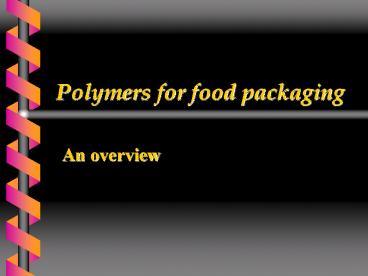Polymers for food packaging - PowerPoint PPT Presentation
1 / 20
Title:
Polymers for food packaging
Description:
Polymers for food packaging An overview Polymers What are polymers? Types of polymer Polymerisation Polymer properties What are polymers Polymers are macromolecules ... – PowerPoint PPT presentation
Number of Views:2265
Avg rating:3.0/5.0
Title: Polymers for food packaging
1
Polymers for food packaging
An overview
2
Polymers
- What are polymers?
- Types of polymer
- Polymerisation
- Polymer properties
3
What are polymers
- Polymers are macromolecules
- They are based on a repeating unit derived from a
small molecule - They may be natural - e.g. polysaccharides - or
synthetic - They possess a variety of properties useful to
food packaging
4
Examples of polymers
- Polyethylene
- LDPE
- HDPE
- Polypropylene
- Polystyrene
- Polyvinyl chloride (PVC)
- Polyethylene terephthallate (PET)
- Polycarbonate
- Polyamide (Nylon)
- Cellulose
- Cellulose acetate
- Cellophane
5
Classification of polymers
- By properties
- Thermoplastic melts on heating
- Thermosetting decomposes on heating
- By Polymerisation process
- Addition
- Condensation
6
Addition polymerisation
- E.g. polyethylene
7
Condensation polymerisation
- E.g. polyester
Teraphthallic acid ethylene glycol --gt PET
8
Mechanical Properties
- Stress and Strain
- Stress Force/Area
- Strain change in length/original length
9
Mechanical Properties (2)
- Yield strength
- Ultimate tensile strength
- Elongation at break
- Burst Strength
- Tear strength
- Stiffness
- Crease or flex resistance
- Coefficient of friction
10
Other properties
- Permeability
- Gases can permeate through polymers
Gas diffused/Area Permeability/thickness x
pressure difference
11
Polymer degradation
- Polymers can be degraded by
- Oxygen
- Heat
- Light
- uv
- These tend to embrittle and weaken the polymer.
12
Polymer processing
- Extrusion
- Blow Moulding
- Injection Moulding
- Thermoforming
- Polymer foams
13
Extrusion
- Molten Polymer is forced through a die by means
of a screw ram.
14
Injection Moulding
- Molten polymer is forced into a mould
15
Vacuum forming
- Polymer sheet is heated using ir heaters
- A vacuum is applied below the sheet, drawing the
sheet into the mould - Related processes are pressure forming and mould
forming
16
Other processes
- Film extrusion
- polymer is extruded into a thin, cylindrical film
which is wound up as film - Blow moulding
- extruded polymer is fed into a mould where it is
blown into shape. This is used to make bottles.
17
Polymer foams
- Polymer is injection moulded with the addition of
foaming agents so that a foam is formed in the
mould. - Typically used for soft drink cups, using
polystyrene where the thermal insulation property
is useful.
18
Other polymer products
- These include various film products
- Laminated films where a number of polymers or
polymer and paper products are layered together - Shrink wrap
- Cling film
19
In conclusion
- An understanding of the relation between the
chemical structure and the physical properties
enables the creation of designer polymers. - As a result the range of polymer products is very
large and growing rapidly - This session is therefore only a very brief look
at polymers.
20
The End































